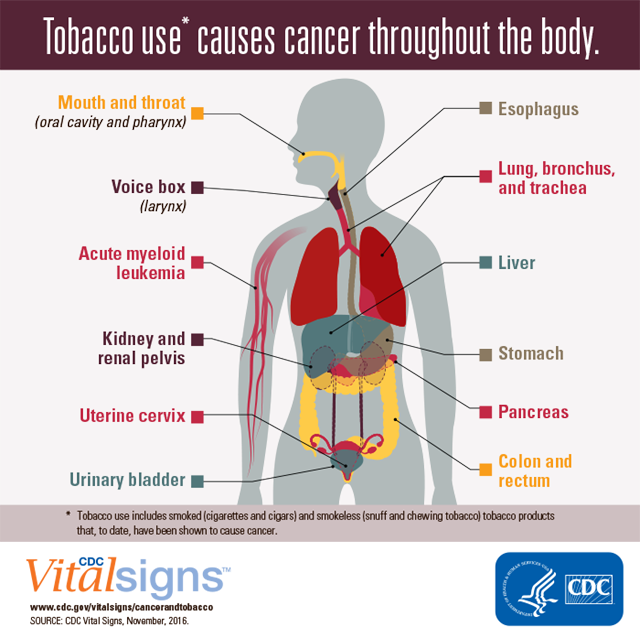Forty percent of cancers in the US are linked to tobacco use. According to the latest CDC Vital Signs report, quitting tobacco use at any age can reduce the risk of getting or dying from cancer. Tobacco use can cause not only lung cancer, but also cancers of the mouth and throat, voice box, esophagus, stomach, kidney, pancreas, liver, bladder, cervix, colon and rectum and a type of leukemia.

Between 2009 and 2013, about 660,000 people in the U.S. were diagnosed with, and about 343,000 people died from, a cancer related to tobacco use each year, according to a new report by CDC. Three in ten cancer deaths were due to cigarette smoking, but progress has been made. Since 1990, about 1.3 million tobacco-related cancer deaths have been avoided.
“When states invest in comprehensive cancer control programs—including tobacco control—we see greater benefits for everyone and fewer deaths from tobacco-related cancers. We have made progress, but our work is not done,” said Lisa C. Richardson, M.D., M.P.H., director of CDC’s Division of Cancer Prevention and Control.
Although fewer people in the US use tobacco now than in the past, more work needs to be done at the state- and community level as well as the individual level to help Americans understand their risk and take steps to quit. States and communities can help by:
- Support comprehensive cancer control programs focusing on cancer prevention, education, screening, access to care, support for cancer survivors, and good health for all.
- Fund comprehensive tobacco prevention and control programs at CDC-recommended levels.
- Making resources more available to people who want to quit.
- Protecting nonsmokers from secondhand smoke in all indoor public places and worksites, including all restaurants, bars and casinos.
To learn more about how to quit and the study’s findings, visit the Vital Signs Cancer and Tobacco Use web page. For more information on our efforts to improve cardiac health, visit our Web site and join our Learning and Action Network to get involved.
